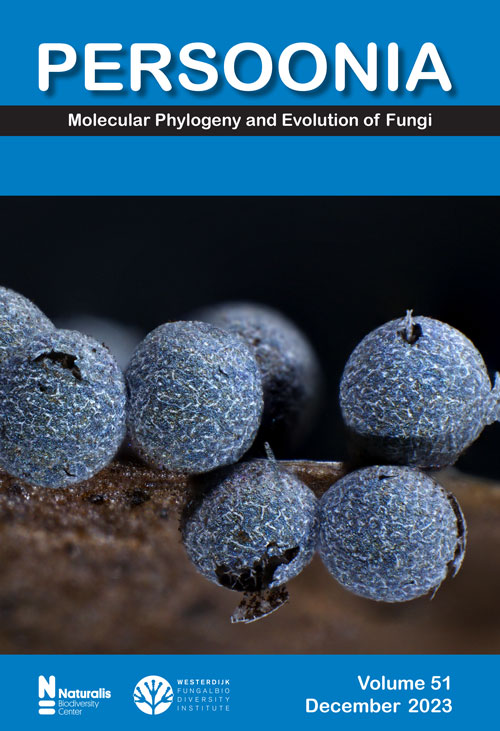Metschnikowiaceae 中 Candida auris- Candida haemuli 支系和相关类群的系统发生组分析,以及 13 个新属、55 个新组合和 9 个新种的提出
IF 7.3
1区 生物学
Q1 MYCOLOGY
引用次数: 0
摘要
念珠菌属(Candida)是酵母菌亚门(Saccharomycotina)中有性生殖酵母菌的一个多态属,有 400 多个种,几乎存在于该亚门的所有科中,其名称与传染性疾病念珠菌病密切相关。在过去 20 年中,大约一半的念珠菌被重新归入 36 个已有属和 14 个新拟属,但该属的多形性特征基本保持不变。白色念珠菌(Candida auris)是一种重要的、全球新兴的机会性病原体,曾在世界各地的医疗机构爆发,造成生命危险。该种属于 Metschnikowiaceae 中的 Candida auris - Candida haemuli(CAH)支系,该支系包含具有多重耐药性的临床相关物种以及从自然环境中分离出来的物种。该支系在系统发育上远离白色念珠菌属的模式种,即寻常白色念珠菌(目前被解释为热带白色念珠菌的异名),属于德巴菌科。尽管以前的系统发生学和系统发生组学研究证实了 C. auris 在 Metschnikowiaceae 中的位置,但这些分析未能确定 CAH 支系在该科中的位置及其与 Clavispora 属和 Metschnikowia 属的分界。为了确定 CAH 支系的位置,研究人员利用氨基酸平均同一性(AAI)值、保守蛋白百分比(POCP)和同源物的存在-不存在模式(PAPO)等指标,进行了系统发生组学和比较基因组学分析,以确定 C. auris 及相关物种在 Metschnikowiaceae 中的系统发生位置。根据这些方法,为各种念珠菌和hyphopichia(包括 Metschnikowiaceae 中 CAH 支系的成员)提出了 13 个新属。因此,C. auris 和相关种被重新归入 Candidozyma 属。引入了 55 个新组合和 9 个新种,这将减少念珠菌属的多型性。本文章由计算机程序翻译,如有差异,请以英文原文为准。
Phylogenomic analysis of the Candida auris- Candida haemuli clade and related taxa in the Metschnikowiaceae, and proposal of thirteen new genera, fifty-five new combinations and nine new species
Candida is a polyphyletic genus of sexually reproducing yeasts in the Saccharomycotina with more than 400 species that occur in almost all families of the subclass and its name is strongly connected with the infectious disease candidiasis. During the last two decades,
approximately half of the Candida species have been reassigned into more than 36 already existing genera and 14 newly proposed genera, but the polyphyletic feature of the genus largely remained. Candida auris is an important, globally emerging opportunistic pathogen that has
caused life-threatening outbreaks in healthcare facilities worldwide. This species belongs to the Candida auris - Candida haemuli (CAH) clade in the Metschnikowiaceae, a clade that contains multidrug-resistant clinically relevant species, but also species isolated from
natural environments. The clade is phylogenetically positioned remotely from the type species of the genus Candida that is Candida vulgaris (currently interpreted as a synonym of Candida tropicalis) and belongs to the family Debaryomycetaceae. Although previous
phylogenetic and phylogenomic studies confirmed the position of C. auris in the Metschnikowiaceae, these analyses failed to resolve the position of the CAH clade within the family and its delimitation from the genera Clavispora and Metschnikowia. To resolve the
position of the CAH clade, phylogenomic and comparative genomics analyses were carried out to address the phylogenetic position of C. auris and related species in the Metschnikowiaceae using several metrics, such as the average amino acid identity (AAI) values, the percentage
of conserved proteins (POCP), and the presence-absence patterns of orthologs (PAPO).Based on those approaches, 13 new genera are proposed for various Candida and Hyphopichia species, including members of the CAH clade in the Metschnikowiaceae. As a result, C. auris
and related species are reassigned to the genus Candidozyma. Fifty-five new combinations and nine new species are introduced, and this will reduce the polyphyly of the genus Candida.
求助全文
通过发布文献求助,成功后即可免费获取论文全文。
去求助
来源期刊

Persoonia
MYCOLOGY-
CiteScore
17.70
自引率
5.50%
发文量
10
审稿时长
3 months
期刊介绍:
Persoonia aspires to publish papers focusing on the molecular systematics and evolution of fungi. Additionally, it seeks to advance fungal taxonomy by employing a polythetic approach to elucidate the genuine phylogeny and relationships within the kingdom Fungi. The journal is dedicated to disseminating high-quality papers that unravel both known and novel fungal taxa at the DNA level. Moreover, it endeavors to provide fresh insights into evolutionary processes and relationships. The scope of papers considered encompasses research articles, along with topical and book reviews.
 求助内容:
求助内容: 应助结果提醒方式:
应助结果提醒方式:


